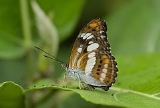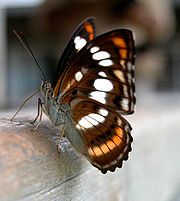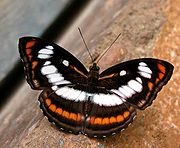
Athyma nefte
Encyclopedia
The Colour Sergeant is a species
of brush-footed butterfly found in tropical South
and Southeast Asia
.
Description based on Bingham.
and Malay Peninsula
.
Male: upperside black with snow-white markings more or less edged with irrorations of blue scales. Fore wing: discoidal streak obscurely divided and uneven along its upper margin; a much-curved and broadly-interrupted discal band white; the latter composed of three outwardly oblique quadrate spots in interspaces 1 u9 1 and 2, and three oblong spots inclined inwards in interspaces 4, 5 and 6, no spot in interspace 3 ; beyond this an inner and an outer subterminal pale line divided by a transverse narrow black band, the former terminating near apex in an obliquely-placed small narrow white spot.
Hind wing: the discal band of the fore wing continued as a subbasal transverse white band: a postdiscal, narrower, more or less macular band also white, and a very distinct pale, still narrower, subterminal band. The interspace between the postdiscal and the subterminal bands darker than the general ground-colour of the wing, and the postdiscal band on the inner side margined with similarly coloured cone-shaped marks.
Underside brown, the white markings as on the upperside but somewhat diffuse, the interspaces of the groundcolour more or less blotched with darker brown, forming on the hind wing a conspicuous discal transverse series of spots in the interspaces; the dorsal margin of the hind wing broadly bluish white.
Antennae, head, thorax and abdomen above dark brownish black, the thorax and base of the abdomen respectively crossed by a bar of bluish white; beneath, the palpi, thorax and abdomen bluish white.
Female: Upperside black, the markings similar to those in the male, but orange-yellow and much broader; on the fore wing the discal band complete, the inner subterminal band much broader and better defined.
Underside: the ground-colour a paler brown than in the male, the markings as on the upperside but pinkish white, the dark brown blotches in the interspaces and the series of dark discal spots on the hind wing more prominent.
, Tenasserim. Probably this subspecies
in southeastern India
(Andhra Pradesh
and surrounding regions). Differs from A. n. nivifera as follows:
Male Upperside. Fore wing: discoidal streak more clearly divided, the preapical portion prominent; discal band broader, the anterior spot composing its posterior half not wider than the others, not outwardly conical; two conspicuous preapical orange-yellow spots. Hind wing: subbasal band slightly broader. Underside: ground-colour a more ochraceous brown; fore wing preapically orange-yellow.
Female Upperside: the markings of a somewhat deeper orange-yellow; the discal band on fore and postdiscal band on hind wing distinctly broader; the inner subterminal narrow band on fore wing ill-defined posteriorly; the preapical spots much smaller. Underside: ground-colour much more ochraceous.
with asita.
 Male: upperside black with snow-white markings more or less edged with irrorations of blue scales. Fore wing: discoidal streak from dusky white to dark ferruginous, with the exception of the preapical portion which is always prominently white; broad, straight and nearly complete white discal band removed from terminal margin and composed of three outwardly oblique quadrate spots in interspaces 1 a, 1 and 2, and three oblong spots inclined inwards in interspaces 4, 5 and 6, a small spot in interspace 3; beyond this an orange-yellow, macular, well-defined inner and a pale outer subterminal line divided by divided only by the black veins, the former terminating near apex in an obliquely-placed mid-sized narrow white spot.
Male: upperside black with snow-white markings more or less edged with irrorations of blue scales. Fore wing: discoidal streak from dusky white to dark ferruginous, with the exception of the preapical portion which is always prominently white; broad, straight and nearly complete white discal band removed from terminal margin and composed of three outwardly oblique quadrate spots in interspaces 1 a, 1 and 2, and three oblong spots inclined inwards in interspaces 4, 5 and 6, a small spot in interspace 3; beyond this an orange-yellow, macular, well-defined inner and a pale outer subterminal line divided by divided only by the black veins, the former terminating near apex in an obliquely-placed mid-sized narrow white spot.
 Hind wing: the discal band of the fore wing continued as a subbasal transverse white band: a postdiscal, narrower, more or less macular band also white, and a very distinct pale, still narrower, subterminal band. The interspace between the postdiscal and the subterminal bands darker than the general ground-colour of the wing, and the postdiscal band on the inner side margined with similarly coloured cone-shaped marks.
Hind wing: the discal band of the fore wing continued as a subbasal transverse white band: a postdiscal, narrower, more or less macular band also white, and a very distinct pale, still narrower, subterminal band. The interspace between the postdiscal and the subterminal bands darker than the general ground-colour of the wing, and the postdiscal band on the inner side margined with similarly coloured cone-shaped marks.
Underside ochraceous light brown, shaded with orange-yellow on apex of fore wing and on the anterior portion of tho postdiscal band on the hind wing; the markings similar on the upperside but somewhat diffuse, the discoidal streak and posterior half of inner sub-terminal band on fore wing and the postdiscal band posteriorly on the hind wing suffused with very pale bluish pink; the interspaces of the groundcolour smallish darker brown blotches, forming on the hind wing a conspicuous discal transverse series of spots in the interspaces; the dorsal margin of the hind wing broadly bluish white.
Antennae, head, thorax and abdomen above dark brownish black, the thorax and base of the abdomen respectively crossed by a bar of bluish white; beneath, the palpi, thorax and abdomen bluish white.
Female: Upperside black, the markings similar to those in the male, but pale orange-yellow and much broader; on the fore wing the discal band complete and very broad, the inner subterminal band reduced to a tornal and two or three preapical spots.
Underside: the ground-colour bright ochraceous yellow, the markings pinkish white, but in great part suffused with pale yellow; the dark brown blotches in the interspaces and the series of dark discal spots on the hind wing more prominent, and on the fore wing large, and in strong contrast with the ground-colour.
cylindrical, with six rows of fine branched spines, the dorsal being lower than the lateral and those on the third and fourth segments lower than the rest, the second segment unarmed; the bases of the legs set with short simple spines. Colour pure green, with a large brown patch on the ninth segment. Spines brown and head dark brown, head covered with short simple brown
spines and white tubercles. Feeds on Glochidion velutinum and G. zelanicum. Pupa
like that of Athyma ranga
, but of the curious processes on the back, the posterior one is much longer and more inclined forwards.
At least on Borneo
but probably elsewhere too, adults - like other Athyma - generally do not visit carrion
or old fruit to drink liquids.
Species
In biology, a species is one of the basic units of biological classification and a taxonomic rank. A species is often defined as a group of organisms capable of interbreeding and producing fertile offspring. While in many cases this definition is adequate, more precise or differing measures are...
of brush-footed butterfly found in tropical South
South Asia
South Asia, also known as Southern Asia, is the southern region of the Asian continent, which comprises the sub-Himalayan countries and, for some authorities , also includes the adjoining countries to the west and the east...
and Southeast Asia
Southeast Asia
Southeast Asia, South-East Asia, South East Asia or Southeastern Asia is a subregion of Asia, consisting of the countries that are geographically south of China, east of India, west of New Guinea and north of Australia. The region lies on the intersection of geological plates, with heavy seismic...
.
Description
- See glossaryGlossary of Lepidopteran termsThis glossary describes the terms used in the formal descriptions of insect species, jargon used mostly by professionals or entomologist....
for terms used
Description based on Bingham.
Athyma nefte nivifera
BorneoBorneo
Borneo is the third largest island in the world and is located north of Java Island, Indonesia, at the geographic centre of Maritime Southeast Asia....
and Malay Peninsula
Malay Peninsula
The Malay Peninsula or Thai-Malay Peninsula is a peninsula in Southeast Asia. The land mass runs approximately north-south and, at its terminus, is the southern-most point of the Asian mainland...
.
Male: upperside black with snow-white markings more or less edged with irrorations of blue scales. Fore wing: discoidal streak obscurely divided and uneven along its upper margin; a much-curved and broadly-interrupted discal band white; the latter composed of three outwardly oblique quadrate spots in interspaces 1 u9 1 and 2, and three oblong spots inclined inwards in interspaces 4, 5 and 6, no spot in interspace 3 ; beyond this an inner and an outer subterminal pale line divided by a transverse narrow black band, the former terminating near apex in an obliquely-placed small narrow white spot.
Hind wing: the discal band of the fore wing continued as a subbasal transverse white band: a postdiscal, narrower, more or less macular band also white, and a very distinct pale, still narrower, subterminal band. The interspace between the postdiscal and the subterminal bands darker than the general ground-colour of the wing, and the postdiscal band on the inner side margined with similarly coloured cone-shaped marks.
Underside brown, the white markings as on the upperside but somewhat diffuse, the interspaces of the groundcolour more or less blotched with darker brown, forming on the hind wing a conspicuous discal transverse series of spots in the interspaces; the dorsal margin of the hind wing broadly bluish white.
Antennae, head, thorax and abdomen above dark brownish black, the thorax and base of the abdomen respectively crossed by a bar of bluish white; beneath, the palpi, thorax and abdomen bluish white.
Female: Upperside black, the markings similar to those in the male, but orange-yellow and much broader; on the fore wing the discal band complete, the inner subterminal band much broader and better defined.
Underside: the ground-colour a paler brown than in the male, the markings as on the upperside but pinkish white, the dark brown blotches in the interspaces and the series of dark discal spots on the hind wing more prominent.
Athyma nefte asita
MyanmarMyanmar
Burma , officially the Republic of the Union of Myanmar , is a country in Southeast Asia. Burma is bordered by China on the northeast, Laos on the east, Thailand on the southeast, Bangladesh on the west, India on the northwest, the Bay of Bengal to the southwest, and the Andaman Sea on the south....
, Tenasserim. Probably this subspecies
Subspecies
Subspecies in biological classification, is either a taxonomic rank subordinate to species, ora taxonomic unit in that rank . A subspecies cannot be recognized in isolation: a species will either be recognized as having no subspecies at all or two or more, never just one...
in southeastern India
India
India , officially the Republic of India , is a country in South Asia. It is the seventh-largest country by geographical area, the second-most populous country with over 1.2 billion people, and the most populous democracy in the world...
(Andhra Pradesh
Andhra Pradesh
Andhra Pradesh , is one of the 28 states of India, situated on the southeastern coast of India. It is India's fourth largest state by area and fifth largest by population. Its capital and largest city by population is Hyderabad.The total GDP of Andhra Pradesh is $100 billion and is ranked third...
and surrounding regions). Differs from A. n. nivifera as follows:
Male Upperside. Fore wing: discoidal streak more clearly divided, the preapical portion prominent; discal band broader, the anterior spot composing its posterior half not wider than the others, not outwardly conical; two conspicuous preapical orange-yellow spots. Hind wing: subbasal band slightly broader. Underside: ground-colour a more ochraceous brown; fore wing preapically orange-yellow.
Female Upperside: the markings of a somewhat deeper orange-yellow; the discal band on fore and postdiscal band on hind wing distinctly broader; the inner subterminal narrow band on fore wing ill-defined posteriorly; the preapical spots much smaller. Underside: ground-colour much more ochraceous.
Athyma nefte inara
Like Athyma nefte nivifera but differing in details. Is found in northeastern India. Appears to be sympatric in AssamAssam
Assam , also, rarely, Assam Valley and formerly the Assam Province , is a northeastern state of India and is one of the most culturally and geographically distinct regions of the country...
with asita.


Underside ochraceous light brown, shaded with orange-yellow on apex of fore wing and on the anterior portion of tho postdiscal band on the hind wing; the markings similar on the upperside but somewhat diffuse, the discoidal streak and posterior half of inner sub-terminal band on fore wing and the postdiscal band posteriorly on the hind wing suffused with very pale bluish pink; the interspaces of the groundcolour smallish darker brown blotches, forming on the hind wing a conspicuous discal transverse series of spots in the interspaces; the dorsal margin of the hind wing broadly bluish white.
Antennae, head, thorax and abdomen above dark brownish black, the thorax and base of the abdomen respectively crossed by a bar of bluish white; beneath, the palpi, thorax and abdomen bluish white.
Female: Upperside black, the markings similar to those in the male, but pale orange-yellow and much broader; on the fore wing the discal band complete and very broad, the inner subterminal band reduced to a tornal and two or three preapical spots.
Underside: the ground-colour bright ochraceous yellow, the markings pinkish white, but in great part suffused with pale yellow; the dark brown blotches in the interspaces and the series of dark discal spots on the hind wing more prominent, and on the fore wing large, and in strong contrast with the ground-colour.
Ecology
CaterpillarCaterpillar
Caterpillars are the larval form of members of the order Lepidoptera . They are mostly herbivorous in food habit, although some species are insectivorous. Caterpillars are voracious feeders and many of them are considered to be pests in agriculture...
cylindrical, with six rows of fine branched spines, the dorsal being lower than the lateral and those on the third and fourth segments lower than the rest, the second segment unarmed; the bases of the legs set with short simple spines. Colour pure green, with a large brown patch on the ninth segment. Spines brown and head dark brown, head covered with short simple brown
spines and white tubercles. Feeds on Glochidion velutinum and G. zelanicum. Pupa
Pupa
A pupa is the life stage of some insects undergoing transformation. The pupal stage is found only in holometabolous insects, those that undergo a complete metamorphosis, going through four life stages; embryo, larva, pupa and imago...
like that of Athyma ranga
Athyma ranga
The Blackvein Sergeant is a species of nymphalid butterfly found in Southwest India and parts of Southeast Asia.-Description:Upperside: Male velvety black, female very dark brown, suffused with bluish in certain lights....
, but of the curious processes on the back, the posterior one is much longer and more inclined forwards.
At least on Borneo
Borneo
Borneo is the third largest island in the world and is located north of Java Island, Indonesia, at the geographic centre of Maritime Southeast Asia....
but probably elsewhere too, adults - like other Athyma - generally do not visit carrion
Carrion
Carrion refers to the carcass of a dead animal. Carrion is an important food source for large carnivores and omnivores in most ecosystems. Examples of carrion-eaters include vultures, hawks, eagles, hyenas, Virginia Opossum, Tasmanian Devils, coyotes, Komodo dragons, and burying beetles...
or old fruit to drink liquids.

